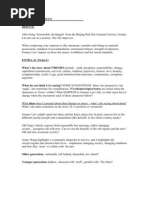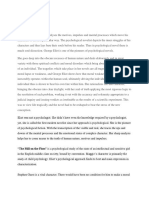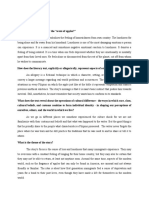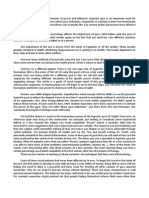0 ratings0% found this document useful (0 votes)
2 viewsMarigold
Marigold
Uploaded by
gao210103Book
Copyright:
© All Rights Reserved
Available Formats
Download as DOCX, PDF, TXT or read online from Scribd
Marigold
Marigold
Uploaded by
gao2101030 ratings0% found this document useful (0 votes)
2 views4 pagesBook
Copyright
© © All Rights Reserved
Available Formats
DOCX, PDF, TXT or read online from Scribd
Share this document
Did you find this document useful?
Is this content inappropriate?
Book
Copyright:
© All Rights Reserved
Available Formats
Download as DOCX, PDF, TXT or read online from Scribd
Download as docx, pdf, or txt
0 ratings0% found this document useful (0 votes)
2 views4 pagesMarigold
Marigold
Uploaded by
gao210103Book
Copyright:
© All Rights Reserved
Available Formats
Download as DOCX, PDF, TXT or read online from Scribd
Download as docx, pdf, or txt
You are on page 1of 4
# Unveiling the Profoundness of "Marigolds"
## I. Introduction
Dear friends, today we are going to embark on a journey into
the world of the novel "Marigolds" by Eugenia Collier. This
remarkable work not only reflects a specific historical era but
also delves deep into the human psyche and the process of
growth.
## II. Historical Background
The story of "Marigolds" unfolds during the 1930s, a time of
the Great Depression in the United States. It was a period of
extreme economic hardship. Unemployment rates soared,
and families across the nation were struggling to make ends
meet. For African Americans, the situation was even more
dire. They faced not only the economic challenges that
plagued the entire country but also the persistent and unjust
burden of racial discrimination. Eugenia Collier drew from
her own early life experiences in rural Maryland to create a
vivid portrait of this era. In this context, the characters in the
novel are constantly shaped and influenced by the poverty
and social inequalities that surround them. Their lives are a
testament to the resilience and the struggle of a community
trying to survive in the face of overwhelming odds.
## III. Nostalgia and Reverie of the Past
In the novel, we can feel a strong sense of nostalgia. The
protagonist, Elizabeth, often looks back on her childhood.
The dusty roads, the simple houses, and especially the
marigolds that stood out in the midst of that dusty
environment, all become symbols of her past. These
memories are bittersweet. They are filled with the joys of
childhood innocence, like the games children played and the
carefree laughter. But at the same time, there is a tinge of
sadness, perhaps due to the hardships that were also a part
of that life. The nostalgia is not just about personal
memories but also about a way of life that was disappearing.
It gives us a window into a bygone era, making us
understand how the past can shape a person's identity and
perspective. It makes us reflect on our own memories and
how they influence who we are today.
## IV. The Dichotomy of Innocence and the Birth of Empathy
At the beginning of the story, Elizabeth and the other
children are in a state of pure innocence. They are naïve and
unaware of the consequences of their actions. They tease
Miss Lottie, an old woman in the community, and they throw
stones at her marigolds. They even laugh at her son who has
some mental disabilities. But as the story progresses, a
transformation occurs. When Elizabeth sees the pain and
sadness on Miss Lottie's face after the marigolds are
destroyed, something clicks in her. She starts to understand
that her actions have caused real harm. This is the birth of
empathy. The contrast between her initial innocence and the
emerging empathy is a powerful theme. It shows us how life
experiences can change a person, how we can grow from
being self-centered to being more aware of others' feelings.
It also makes us think about the importance of empathy in
our own lives and how we can cultivate it.
## V. From the Embrace of Youth to the Realm of Adulthood
Elizabeth's journey is also one of growing up. In her youth,
she is carefree and only concerned with the immediate
pleasures and small dramas of childhood. But as the events
in the story unfold, she is forced to face the harsh realities of
life. The poverty, the discrimination, and the consequences
of her own actions all contribute to her transition into
adulthood. When she destroys the marigolds, it is a symbolic
act of leaving her childhood behind. She starts to take
responsibility for her actions and to understand the
complexity of the world. This process is not easy. It is filled
with pain and self-doubt. But it is also a necessary part of
growing up. It shows us that adulthood is not just about age
but about a state of mind, a willingness to face the
challenges and to learn from our mistakes.
You might also like
- Psychopathology - Research, Assessment and Treatment in - Davey, Graham - 2014 - Chichester, West Sussex - Wiley - 9781118897324 - Anna's ArchiveDocument652 pagesPsychopathology - Research, Assessment and Treatment in - Davey, Graham - 2014 - Chichester, West Sussex - Wiley - 9781118897324 - Anna's ArchiveCristina MarinNo ratings yet
- EXTRA' by LI YIYUNDocument3 pagesEXTRA' by LI YIYUNSteve Lim100% (1)
- Easy Peasey 1Document5 pagesEasy Peasey 1Karolina Pósa BozóNo ratings yet
- Essay Are We There YetDocument2 pagesEssay Are We There Yetgustawgluszak07No ratings yet
- Corrige de La SyntheseDocument3 pagesCorrige de La Synthesealimont95No ratings yet
- All Themes One ShotDocument21 pagesAll Themes One ShotAyush KukshalNo ratings yet
- Rebels with a Cause: Reimagining Boys, Ourselves, and Our CultureFrom EverandRebels with a Cause: Reimagining Boys, Ourselves, and Our CultureNo ratings yet
- Alice Walker Everyday Use EssayDocument53 pagesAlice Walker Everyday Use Essaypaijcfnbf100% (3)
- English Dhan 'S ProjectDocument7 pagesEnglish Dhan 'S Projectdhanpatel2006No ratings yet
- Little Women 2nd SEMESTERDocument2 pagesLittle Women 2nd SEMESTERVictória RussowskyNo ratings yet
- Reflection Paper of 21ST Century LiteratureDocument4 pagesReflection Paper of 21ST Century Literaturexylonpo13No ratings yet
- A Life Changing Experience EssayDocument55 pagesA Life Changing Experience Essayuwuxovwhd100% (2)
- Wilson DressDocument7 pagesWilson DressJessica MaryNo ratings yet
- RECITATIFDocument8 pagesRECITATIFjalyNo ratings yet
- Literary analysisDocument3 pagesLiterary analysisalyannatambalque2106No ratings yet
- RESEARCH LITERARY ANALYSIS OUTLINEDocument15 pagesRESEARCH LITERARY ANALYSIS OUTLINEJean TalisicNo ratings yet
- Tale of Two Cities Essay TopicsDocument5 pagesTale of Two Cities Essay Topicsb72d994z100% (2)
- I Stand Here IroningDocument3 pagesI Stand Here IroningRoslina Rosdi100% (1)
- Turquoise Dreams: Anthology of short stories by Zimbabwean womenFrom EverandTurquoise Dreams: Anthology of short stories by Zimbabwean womenNo ratings yet
- Untitled DocumentDocument2 pagesUntitled DocumentcoretezsmithNo ratings yet
- Philo - Omelas ReadingDocument2 pagesPhilo - Omelas ReadingEla Mae CoNo ratings yet
- annotated-WP2 RevisedDocument9 pagesannotated-WP2 Revisedterrence5353No ratings yet
- We Need To Talk About Kevin, Lionel Shriver. Reading Report - Vélia DichtelDocument9 pagesWe Need To Talk About Kevin, Lionel Shriver. Reading Report - Vélia Dichteljhgmcx46dkNo ratings yet
- The Mill On The FossDocument5 pagesThe Mill On The FossDanyal Khan100% (1)
- Second Wind: Navigating the Passage to a Slower, Deeper, and More Connected LifeFrom EverandSecond Wind: Navigating the Passage to a Slower, Deeper, and More Connected LifeNo ratings yet
- I Must Have Wandered: An Adopted Air Force Daughter RecallsFrom EverandI Must Have Wandered: An Adopted Air Force Daughter RecallsNo ratings yet
- Omelas Rip1Document1 pageOmelas Rip1api-315420231No ratings yet
- MarigoldsDocument4 pagesMarigoldsAlejandra AlbinoNo ratings yet
- Analysis - A Good Man Is Hard To FindDocument2 pagesAnalysis - A Good Man Is Hard To Finddr6rwh4mm5No ratings yet
- CulturalimmersionDocument10 pagesCulturalimmersionapi-258919645No ratings yet
- Olimpain_Emraida_FinalPaperDocument4 pagesOlimpain_Emraida_FinalPaperEmraida OlimpainNo ratings yet
- Critical Essay #1Document4 pagesCritical Essay #1cerberus1015No ratings yet
- Double-Standard AgingDocument5 pagesDouble-Standard AgingBrindusacNo ratings yet
- Like A House On Fire Student Doc 9 10Document2 pagesLike A House On Fire Student Doc 9 10d4t4d5en53No ratings yet
- Wgss FinalDocument8 pagesWgss FinalJiyun WooNo ratings yet
- DIAH ALIFIONNA ARIANINGTYAS - 20230710164620 - SOCS6045024 - LC61 - FIN - ConfDocument5 pagesDIAH ALIFIONNA ARIANINGTYAS - 20230710164620 - SOCS6045024 - LC61 - FIN - ConfDionna ArianingtyasNo ratings yet
- HOMS Final -- Neelesh GovindDocument5 pagesHOMS Final -- Neelesh GovindneelyiomanNo ratings yet
- American Identity EssayDocument58 pagesAmerican Identity Essayfz749jm7No ratings yet
- English s6 The Boy Behind The Curtain Resource 2 Chapter SummariesDocument4 pagesEnglish s6 The Boy Behind The Curtain Resource 2 Chapter SummariesZak Ayoubi0% (1)
- Post Colonial Criticism in Santos' Scent of Apples.Document1 pagePost Colonial Criticism in Santos' Scent of Apples.Julie Ann Longoria BelaroNo ratings yet
- Essays On Growing UpDocument7 pagesEssays On Growing Upafabeaida100% (2)
- The Joy Luck Club Literary Criticism Revised EssayDocument3 pagesThe Joy Luck Club Literary Criticism Revised Essayapi-269570988No ratings yet
- 09 Chapter3Document63 pages09 Chapter3Alyna FathimaNo ratings yet
- Essays On BeautyDocument8 pagesEssays On Beautyd3hayy25100% (2)
- Empowering H.I.M:: Saving Our Black Boys Through Positive Male MentoringDocument5 pagesEmpowering H.I.M:: Saving Our Black Boys Through Positive Male MentoringJohnathan Greene Jr.No ratings yet
- Writing A Personal Experience EssayDocument7 pagesWriting A Personal Experience Essayafhbgufyf100% (2)
- The LessonDocument6 pagesThe LessonNoodle1207No ratings yet
- ENGLISHDocument2 pagesENGLISHbittusingh0027uNo ratings yet
- 2024 - 05 - 06 Prep PaperDocument5 pages2024 - 05 - 06 Prep Paperdavekreon.sopandi.shsNo ratings yet
- James Joyce sistersDocument2 pagesJames Joyce sistersbolkvadzeninnaNo ratings yet
- SNW Job DescriptionDocument1 pageSNW Job DescriptionValerie F. LeonardNo ratings yet
- OBoyle Aquinis 2012 Best and The Rest - Bell CurveDocument41 pagesOBoyle Aquinis 2012 Best and The Rest - Bell CurveforbesadminNo ratings yet
- PSY 215 4-2 Project OneDocument9 pagesPSY 215 4-2 Project Onelessonlearned73No ratings yet
- 1 The Material Self or Economic SelfDocument38 pages1 The Material Self or Economic SelfJavadd Kilam100% (1)
- Reality Catches Up With AussiecoDocument7 pagesReality Catches Up With AussiecoArjun ChalanaNo ratings yet
- Main Lesson - Menu Fidelity ToolDocument3 pagesMain Lesson - Menu Fidelity Tooljakbnimbl7201100% (1)
- Hypnotic GazeDocument4 pagesHypnotic GazePaul Moraru83% (6)
- Wmels Guiding PrinciplesDocument10 pagesWmels Guiding Principlesapi-236332996No ratings yet
- Manifesto WorkshopDocument5 pagesManifesto WorkshopJackson VonkNo ratings yet
- Welcoming Early ChildhoodDocument8 pagesWelcoming Early ChildhoodHarry Maan100% (1)
- MutismDocument56 pagesMutismlaviNo ratings yet
- 12312322Document3 pages12312322Christopher BorkinNo ratings yet
- 3rd Lesson Plan Multiplication RDocument2 pages3rd Lesson Plan Multiplication Rapi-301142304No ratings yet
- GRT1 Sample ReportDocument4 pagesGRT1 Sample Reportm.roseNo ratings yet
- Book On AutismDocument1 pageBook On AutismAbd ALRahmanNo ratings yet
- PositioningDocument2 pagesPositioningKishan AndureNo ratings yet
- Abubakar 2014Document13 pagesAbubakar 2014tommy maulanaNo ratings yet
- Guest Speaker Reflection 2Document3 pagesGuest Speaker Reflection 2api-484826404No ratings yet
- LESSON PLAN in VALUES EDUCATIONDocument3 pagesLESSON PLAN in VALUES EDUCATIONGerick Dave Monencillo Vender75% (4)
- CONTROL Your ANGER Before Your Anger Controls YouDocument50 pagesCONTROL Your ANGER Before Your Anger Controls YouRonel M. Buid100% (4)
- MBA As A Learning Organization PDFDocument18 pagesMBA As A Learning Organization PDFAzim MohammedNo ratings yet
- The Grief and Communication Family Support Intervention Intervention Fidelity Participant Experiences and Potential OutcomesDocument13 pagesThe Grief and Communication Family Support Intervention Intervention Fidelity Participant Experiences and Potential OutcomesAriani SukmadiwantiNo ratings yet
- Performance Evaluation Rating SystemDocument10 pagesPerformance Evaluation Rating SystemfatimaadessaNo ratings yet
- Assignment 2Document9 pagesAssignment 2api-321064589No ratings yet
- The Dynamics of Psychological Security-Insecurity: Brooklyn CollegeDocument15 pagesThe Dynamics of Psychological Security-Insecurity: Brooklyn Collegetanisya aurely12No ratings yet
- SCS 2: From Unit 2 - Kounin's Model of DisciplineDocument32 pagesSCS 2: From Unit 2 - Kounin's Model of DisciplineBincyNo ratings yet
- ثلاث نظريات للتعايم التنطيميDocument645 pagesثلاث نظريات للتعايم التنطيميqoseNo ratings yet
- Consumer Decision MakingDocument8 pagesConsumer Decision Making9986212378No ratings yet

























































































